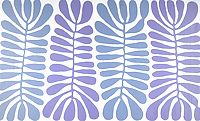Mitjili Napurrula
About Mitjili Napurrula
Uwalki: Watiya
The subtitle of the painting, Watiya Tjuta, indicates that it relates to men’s wooden objects. The Tjukurrpa or Dreaming of this work concerns making spears, an important aspect of men’s business. The straightening of spears is a theme frequently painted by Mitjili Napurrula’s brother, Turkey Tolson.
Mitjili is known for the strength of patterning in the formal arrangements of her work, as in this representation of the woman’s side of this Tjukurrpa, the trees that provide the wood for spear shafts and other objects. The country where the trees are found is Uwalki, Mitjili’s father’s country. She was taught her father’s Tjukurrpa by her mother, who drew images in the sand of Uwalki. She says, “My mother taught me my father’s Tjukurrpa; that’s what I’m painting on the canvas.”
This country, near the Kintore Range, west of Haasts Bluff (which in turn is west of Alice Springs), is rich in bush food, with plenty of native grass seeds for bush damper, as well as animals such as turkeys and kangaroos. Stands of desert oaks form vertical patterns against the shimmering sands.
Biographical Notes
Mitjili Naparrula was born at Haasts Bluff in 1945 and started painting for the Ikuntji Women’s Centre in1993. She is the daughter of Tjunkiya Napaltjarri, a painter at Kintore. Her brother, Turkey Tolson Tjupurrula, is the chairman of Papunya Tula Artists, and she is married to Long Tom Tjapanangka.
Mitjili has exhibited throughout Australia since 1994 and has held several solo and been included in over 60 exhibitions. Her work is in major Australian collections including:
• the National Gallery of Australia; • Art Gallery of New South Wales; and • Flinders University Art Museum, South Australia.
Jan 2005
Source: “Spirit Country” Contemporary Australian Aboriginal Art by Jennifer Isaacs Haasts Bluff
Haasts Bluff is 150 miles west of Alice Springs. It is in a picturesque setting on the plans between two mountain ranges, which turn purple in the evening light, creating archetypal Central Australia scenic views in the hues of Namatjira.
The hills are dotted with clumps old spinifex grass and white ghost gums, while the plains support river gums and patches of mulga. To the west are stands of desert oak against red sandhills.
A permanent Lutheran settlement was established in 1935 and the Haasts Bluff community included Pintupi, Ngalia, Warlpiri, Pitjantjatara and Arrente people.
The community became active in painting again from August 1992 when the Ikuntji Women’s Centre provide health education and child care and supplied art materials and conducted painting workshops.
The women of Haasts Bluff make lively and vital art, characterized by a free use of paint with little dotting and a textured quality
